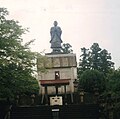Sado (Niigata)
| Sado-shi 佐渡 市 |
||
|---|---|---|
|
|
||
| Geographical location in Japan | ||
| Region : | Chūbu | |
| Prefecture : | Niigata | |
| Coordinates : | 38 ° 1 ' N , 138 ° 22' E | |
| Basic data | ||
| Surface: | 855.10 km² | |
| Residents : | 52,928 (October 1, 2019) |
|
| Population density : | 62 inhabitants per km² | |
| Community key : | 15224-2 | |
| Symbols | ||
| Flag / coat of arms: | ||
| Tree : | Hinoki cypress | |
| Flower : | Yellow-red daylily cv. Kwanso | |
| Bird : | Nipponibis | |
| Fish : | Seriola quinqueradiata | |
| town hall | ||
| Address : |
Sado City Hall 232 Chigusa Sado shi Niigata 952-1292 |
|
| Website URL: | http://www.city.sado.niigata.jp | |
| Location of Sados in Niigata Prefecture | ||
Sado ( Japanese 佐渡 市 , - shi ) is a city on the island of Sado in Niigata Prefecture in Japan .
history
The city of Sado was formed on March 1, 2004 from the Shi Ryōtsu ( 両 津市 , -shi ), the Machi Aikawa ( 相 川 町 , -machi ), Sawada ( 佐 和田 町 , -machi ), Kanai ( 金井 町 , -machi ), Hatano ( 畑 野 町 , -machi ), Mano ( 真 野 町 , -machi ), Ogi ( 小木 町 , -machi ), Hamochi ( 羽 茂 町 , -machi ), as well as the Mura Niibo ( 新 穂 村 , -mura ) and Akadomari ( 赤 泊 村 , -mura ). The city thus extends over the entire island.
traffic
- Street
- National road 350
sons and daughters of the town
- Arita Hachirō (1884-1965), diplomat
- Fubō Hayashi (1900-1935), writer
- Kita Ikki (1883–1937), political philosopher of the Shōwa period
- Homma Masaharu (1887–1946), command officer
Attractions
Numerous sights are distributed over the urban area, which has been very extensive since the villages were merged.
- The Myosen temple is the only one in Niigata prefecture to have a five-story pagoda and is located around 5 km east of Mano. The pagoda was built by two generations of carpenters and completed in 1825 after 30 years of construction. The temple was founded by a samurai who later followed Nichiren 's teachings .
- Not far from the Myosen Temple, the small, secluded Daizen Shrine is well worth seeing. The wooden building of a traditional Noh theater , in which performances are still taking place, can be seen on its grounds . In the vicinity of the Daizen shrine, a few farms in traditional style have been preserved.
- In the village of Niibo, almost exactly in the middle of the island, the Konpon temple is worth seeing. It was built in the 17th century on the spot where Nichiren initially lived during his exile on the island (1271–74).
- In the small port of Ogi in the southwest of the island, large wooden troughs, called taraibune in Japanese , were used as watercraft to collect mussels and seaweed. This tradition is still demonstrated to tourists today. The Ogi Minzoku Hakubutsukan Museum is also worth visiting in Ogi .
- Nichiren lived for two years a few kilometers northeast of the present-day town of Sawata on the site where the Myosho Temple now stands. This temple, which is surrounded by a garden, is the destination of many pilgrims today, as is Jisso Ji, not far to the south . It was built in a place that Nichiren often went to for meditation. The pine tree on which Nichiren used to hang his robe can still be seen today. Not far from the temple, a large, widely visible Nichiren monument was erected
- On the west coast of the island, the Art and Natural History Museum of Sado , located between Sawata and Mano, is worth seeing. In his garden, stilt houses were reconstructed, which correspond to the original architectural style of the Sado residents. The museum also houses some stuffed specimens of the rare nipponibite , which was memorialized in Niibo village.
- On the hardly inhabited north coast of the island, some striking rock formations are well-known excursion destinations. These include the like two turtle shaped Futatsugame and the 167 m high Onogame where a Shinto deity to live. Not far from the village of Kitaebisu, Senkakuwan Bay is worth a visit, where numerous other bizarre rocks can be seen.
- Near Aikawa on the west coast of the island, gold discoveries in 1601 triggered a gold rush that lasted until 1867, so that Aikawa grew into a town with around 100,000 inhabitants at times. In the vicinity of Aikawa, the Sado Kinzan gold mine, which was converted into a museum , which was only closed in 1989, and the former open-cast mine Doyu no Waretu are worth a visit.
- Aikawa has two other museums: the Kyodo Hakubutsukan Folklore Museum and the Sado Hangamura Art Museum , in which woodcuts by artists who worked on Sado are shown and can also be purchased.
Individual evidence
- ↑ Shobunsha Publications: Niigata to Sadogashima , p. 241. Tokyo 2002. ISBN 4-398-14261-4
- ↑ Chris Taylor: Japan , p. 534.Stefan Loose Verlag, Berlin 1998
- ↑ Shobunsha Publications: Niigata to Sadogashima , p. 243. Tokyo 2002. ISBN 4-398-14261-4
- ↑ Chris Taylor: Japan , p. 532. Stefan Loose Verlag, Berlin 1998
Web links
Commons : Sado - collection of images, videos and audio files











